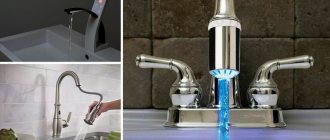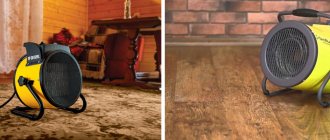A main pipeline with natural gas or a cylinder with a propane-butane mixture ensures the operation of a large number of industrial and household appliances and serves as a source of space heating in the winter. The comfort that the use of gas fuel brings into our lives cannot be estimated. However, there is a flip side to the coin. Major accidents caused by gas leaks are regularly reported through the media. The ability of natural gas fuel to create an explosive mixture with air requires the search for additional measures to prevent the occurrence of a critical situation.
Types of signaling devices
In total, there are two types of sensors that monitor the level of gas pollution in the room: a device with a valve and a device with GSM control. Each of them has individual characteristics. Let's look at two options in more detail:
- Gas sensor with valve. This is an independent device that can not only detect a leak, but also eliminate its possible consequences (explosion, poisoning). This is ensured using a shut-off valve placed inside, which blocks the supply of blue fuel to the heating equipment or gas stove. Such devices are characterized by increased safety, but have a significant drawback - there is a possible risk of false alarms, for example, if tobacco smoke or street fire has entered the room. For household services, a sensor with electromagnetic control is used. That is, when a leak is detected, a signal is sent to the receiver, and the device, using electrical energy, prevents further gas from entering the room. Powered by electricity.
- GSM control. This sensor option is no less popular and is suitable for those who constantly use smartphones or other compact gadgets. Such a detector can be synchronized with a mobile phone using GSM networks, as a result of which, in the event of a leak, notifications, calls or SMS will be sent to the phone. Such applications even have the ability to remotely control the current situation (turn off the gas supply, etc.).
Of the listed types of sensors, the GSM version will be more expensive, but it will be more effective. It also has its downside. If a person is in an inaccessible area to receive a mobile signal, then the alarm notification will not reach the owner of the house in a timely manner.
Gas analyzer with GSM control Source onlinetrade.ru
Service
The equipment arrives from the manufacturer to the end user calibrated and does not require additional configuration or preparatory work during commissioning. This is evidenced by the corresponding entry in his passport, the quality control department stamp and the date of inspection.
But after installation you cannot ignore it:
- Once every 3-4 weeks, you need to clean the location of the device from dust with a vacuum cleaner;
- Use a slightly damp cloth to wipe the device, especially carefully in the area where the sensitive component is located;
- Periodically check the functionality of the sensor. To do this, for example, you can bring a lighter to the area of the sensitive element and apply gas for a few seconds. After triggering, you must make sure that the sound alarm is clearly audible and the light alarm is working;
- After checking, the detector should automatically return to normal operation;
- If the performance test was carried out together with the shut-off valve, you must manually cock the shut-off valve rod to supply gas to the equipment.
Rating of the best sensors as of 2021
In this section we offer a detailed rating, which includes device models that deserve attention. Each device will be reviewed in a table that will provide a detailed overview of the features, as well as the pros and cons of each specific device.
| Place in the ranking | Model | Description of features | Advantages and disadvantages | Price as of March 2021, rub. |
| 1 | Xiaomi Mi Honeywell Gas Alarm | The detector, which best determines gas pollution in a room, is highly sensitive to methane leaks. There is the possibility of light, sound and GSM notification. | Pros: convenient case; clearly visible signal; ease of use; fast reaction. Cons: one of the expensive models; does not “feel” carbon monoxide and other harmful fumes. | 3 270 |
| 2 | Rubetek KR-GD13 | A convenient, compact device that is not very noticeable. Has a screaming siren that can be heard at the opposite end of the house. Suitable for mansions and country cottages. Gives a sound signal and sends SMS messages and Push notifications to your smartphone. | Pros: compact; multifunctionality; comfortable notification system; ease of operation; clear interface. Cons: too high sensitivity. | 2 980 |
| 3 | First Alert OneLink GLOCO-500 | An advanced gas analyzer that works via Wi-Fi and has the ability to connect to a smartphone or tablet using a special application. The sensor model is considered universal because it can also indicate a lack of CO in the air. | Pros: multifunctionality; high sensitivity; Wi-Fi support; displays deviations from the norm. Cons: too high price. | 5 310 |
| 4 | Bradex Guardian | The device is suitable for installation in any room. Capable of sensing leaks of natural, carbon dioxide, and carbon dioxide. There is a built-in catalyst inside the device, which heats up when there is a minimum concentration of gas in the air. | Pros: high sensitivity; a loud enough signal; able to function in different conditions; works stably on electricity. Cons: there is no way to send a signal to a smartphone. | 1 090 |
| 5 | Alfa 501 | Model of the sensor equipped with a shut-off valve. It is a fairly sensitive unit, it perceives from 0.1% of gas in the air. Designed for installation in rooms where gas equipment is installed. | Pros: operational efficiency; convenient functionality; fast installation that does not require professionalism. Cons: at high temperatures it can produce failures and false signals. | 2 690 |
| 6 | Bastion B40 DG | The equipment is intended for installation on the wall; they try to install it directly next to gas appliances. Operating temperature range -10-+45 degrees. | Pros: powerful detection system; high sensitivity; interacts with other protective systems in the house; compact body. Cons: can only sense the concentration of natural gas in the air. | 800,00 |
| 7 | Testo 317-2 | The unit, which does a good job of detecting leaks in pipelines, uses built-in batteries to maintain operation at all times. All measurement results are displayed on a small LCD monitor. | Pros: quick response; convenience; ease of operation; ability to work autonomously; high accuracy of readings; durable body; high sensitivity. Cons: duration of inclusion; high price. | 14 900 |
How does a gas sensor work?
The sensor consists of a sensitive element to a particular group of substances. When the gas concentration changes, the sensitive element changes its physical properties, for example, resistance.
When gas contamination reaches a certain concentration (density in the air), the resistance of the device decreases/increases to a certain value, which will cause a danger signal to be issued (see Sound alarms).
According to the method for determining the permissible concentration of toxic substances in the surrounding space, equipment is divided into three groups.
| With semiconductor sensing element | |
| consists of a flint plate coated with a thin layer of metal oxide. When the surface of the plate is exposed to gas, the film absorbs it and changes its internal resistance, the value of which directly depends on the concentration. They are widely used in everyday life due to their simple and inexpensive design. They are of little use for industrial use because they have insufficient accuracy in determining certain gases, react slowly, have a long recovery time after activation and require constant monitoring of their performance. | |
| Catalytic | |
| They are based on the principle of burning a volatile substance and converting it into water and carbon dioxide when an air flow with an increased concentration of flammable (toxic) substances passes through the analyzer. Used to control gas concentrations at industrial facilities. | |
| Infrared | |
| The infrared electromagnetic spectrum, in which the gas absorption band is located, is monitored. Used to determine leaks during the operation of low-power industrial equipment. They have a fast response, ease of operation and a minimum number of false alarms. | |
Based on the principle of operation, they are divided into two categories: wireless and wired.
For the wired version to function, it must be connected to a 220V power supply.
This design implies ease of maintenance and low cost. The disadvantages include high energy consumption during operation and dependence on the availability of a stable, trouble-free supply of electricity.
Wireless models do not have this drawback; they are equipped with an individual rechargeable battery installed directly in the device body. This design presupposes their use almost anywhere.
Best areas for equipment installation
To install a gas detector, they try to choose the room in which the gas equipment is directly installed. Places for mounting the sensor can be:
- kitchen. In this room, it is advisable to fix the device directly next to the heating device, gas stove or gas main. Moreover, it is desirable that the device is located at a good distance from open fire;
- living room. In this residential area, it is allowed to install the analyzer device on the ceiling surface or a free section of the wall. If there is no equipment in this room, then it is best to use the high sensitivity option;
- bedroom. Since people mainly relax in this room and may not feel a leak, installing a gas analyzer here is simply necessary. It is best to place the sensor above the door in this room;
- loggia. This is the room in which it is necessary to have at least two sensors or one that is sensitive to all types of gas, including methane and carbon monoxide. It is desirable that the controllers be additionally equipped with a shut-off valve.
Installation of a gas leak sensor is also possible in the corridor or hallway. Here they try to place the device at the top point of the wall or ceiling.
The gas sensor can be installed under the hood, provided that it is 1 meter away from the gas stove Source kupisantehniky.ru
A gas analyzer with a built-in plug can be installed in an outlet located near the hood or near gas equipment Source medtech-perm.ru
On a note! It is fundamentally wrong to install a gas alarm in a corner, in closets, or near roller blinds or Roman blinds. It is not advisable to place the device in a window opening. The result is incorrect operation of the device.
A compact and ergonomic sensor for analyzing gas leaks can be installed in the bedroom or living room Source onlinetrade.ru
Gas alarms in your city
Gas alarm. Household gas leak detector. Gas leak alarm.
⇆
To reliably protect your home from gas pollution, proper design and operation of ventilation systems is very important.
When a kitchen hood above the stove is connected to the only natural ventilation channel in the kitchen, then the filters, valves and fan in the kitchen hood practically block the natural draft in the ventilation channel.
A kitchen with the hood turned off remains without ventilation, which impairs air exchange throughout the house and creates a threat of gas accumulation in the room.
Continue reading: “How to properly create natural ventilation in the kitchen”
More articles on this topic:
⇒ Honeywell gas control alarm - review and rating
More articles on this topic
- How to check the winding of electrical equipment
- How to properly make a floor screed in a private house
- How to make a roof from corrugated sheets on the roof of a house
- How to build a house cheaply - inexpensively
- Room thermostat for gas boiler from Aliexpress from China
- How to reduce the high gas consumption of a boiler for heating a house
- Forced ventilation device in a private house
- Interior decoration of house walls made of aerated concrete, gas silicate
Rules to be followed during installation
Often, a device that monitors gas leaks in the house is installed in the kitchen or dining room (if there is one). For example, the most popular heating source today is natural gas.
Since during leaks it tends to accumulate in the upper part of the room (that is, under the ceiling). Consequently, the installation of monitoring equipment must be carried out approximately within this perimeter. It is also important to know several prohibitions regarding the installation of sensors:
The gas sensor is often mounted on a factory-provided strip or directly plugged into an outlet. Source m.onlinetrade.ru
- near an open fire - a minimum distance of 1 m or more.
- near windows, ventilation shafts, chimneys;
- near areas where fat may form, droplets of moisture;
- close to the place where flammable materials are stored (paint, alcohol, kerosene, gasoline).
It is noted that the installation height of the device is selected depending on the type of device. In this case, it is necessary to focus on the characteristics specified in the instructions for use.
Gas analyzers should not be disassembled yourself unless absolutely necessary Source m.onlinetrade.ru
Operating rules
The gas sensor is mounted on a flat, solid, dry wall surface at the level specified in the operating instructions (the installation height depends on the type of substance used).
The installation location is selected so that the operating temperature ranges from -10°C to + 60°C. When installed outdoors, the sensor must be reliably protected from the influence of adverse weather factors.
Particular attention should be paid to the influence of water and rain (see Water sensors). Installation in rooms with high humidity is not allowed. If model tolerance allows, it can be installed in an explosive area (see Explosion-proof sounders).
Installed as close as possible to sources that could become a potential cause of leakage: threaded connections, gas meter, gas taps.
To analyze gases that are heavier than air, the device is installed near the floor or at the lowest point; for substances lighter than air - at the highest possible height; for carbon monoxide? at a height of 1.5 m from the floor.
Prohibited:
- Perform installation directly on gas and other equipment (furniture, shelving);
- Install the equipment in a room that does not have natural supply and exhaust ventilation (where there is no air flow circulation);
- Installation in places with increased air circulation (windows, doors, ventilation ducts);
- Install in rooms used for storing ammonia, aerosols, fuels and lubricants.
Only qualified and professionally trained personnel are allowed to install the equipment and put it into operation.
Tips for choosing a device
In order not to make a mistake when purchasing a room gas sensor, you must follow some rules regarding the choice. In order not to get confused in them, in this section we suggest you figure out what exactly you should pay attention to.
- Service life of sensors. This is stated in the technical documentation. It is believed that the longer the device lasts, the better; accordingly, such a model will cost more. But you need to monitor the sensors more often, as it may be necessary to replace them due to failure.
- Availability of a tester. Almost every piece of equipment has a built-in tester that can determine how functional the device is at the moment. The most convenient option is the one with a button. When pressed, the device automatically performs a self-test.
- Availability of a certificate. Before purchasing a gas analyzer, make sure that the documentation for it includes a certificate of verification work, as well as a document confirming that the device has passed metrological studies and testing.
A typical compact gas alarm for a home or apartment Source onlinetrade.ru
In addition, when choosing alarms, pay attention to a number of parameters outlined below:
- type of gas: methane, liquefied, carbon dioxide;
- sensitivity: in relation to CO - 20 mg/m3, fuel - 10%;
- types of sensors: chemical or physical;
- period of operation - from 10 years;
- The service life of sensitive parts is 3.5 years.
There is always the opportunity to pay attention to more expensive models with a certain set of additional functions.
Legal impunity?
I’ll say right away that the individual entrepreneur was right and contacting Rospotrebnadzor or the police will most likely not yield anything in this case, but we’ll talk about this below.
Such devices are indeed “products of a technically complex nature” and, according to Article 25 of the Law of the Russian Federation dated 02/07/1992 N 2300-1 (as amended on 06/04/2018) “On the Protection of Consumer Rights”, are not subject to exchange or return, provided they are properly quality.
As a rule, scammers do not sell broken devices. What's the point if they buy dozens of them in nearby stores?
So sniffable gas detectors and analyzers, gas alarms, universal air pollutant detectors and similar devices are properly packaged and supplied with the necessary technical documentation from the manufacturer.
Here is an excerpt from the explanations given on this matter by the Office of Rospotrebnadzor for the Bryansk region in January 2021:
What do lawyers advise us in this case?
It’s clear that lawyers are all over the place, but what happens in practice?
But in practice the situation is as follows. Contacting the police, as a rule, does not yield results.
Here is how the head of the press service of the city department of the Ministry of Internal Affairs of Chelyabinsk, Svetlana Kalmykova, commented on a similar situation:
Well, okay, you say, but what about the references to the mandatory installation of devices, because this is what sellers put pressure on and mislead the buyer! Isn’t this “deliberate distortion of the truth - deception” for the purpose of theft, and not a reason to be accused of fraud (Article 159 of the Criminal Code of the Russian Federation)?
A reason, of course, if there is evidence. For example, are there audio/video recordings or witness statements? No?! Well, no, no trial!
Of course, there were appeals to the court and some cases were even won, at first. The reasons for a positive court decision in some cases were: absence or improperly executed documents when making a transaction; malfunction or incompleteness of the device; deceiving the buyer and so on….
But! Fraudsters' knowledge of legal subtleties is growing before our eyes, and now they skillfully insure themselves, taking into account those nuances on which a court decision might not be in their favor. The following phrases can now be found in contracts:
Even rare fines from Rospotrebnadzor no longer frighten dodgers and are easily challenged by them in court.
Actually, many of them not only do not hide, but are not even ashamed of their “activities”!
For example, Mr. A. Fakhrislamov, general director of the notorious Vector-A LLC in Chelyabinsk, explains the “work” of his company:
Well, why not Robin Hood?! After all, it’s for our benefit! Despite the “human factor”.
But for some reason I don’t want to say “thank you” to him...
Why does a gas leak occur in a house or apartment?
Natural gas leaks occur for various reasons. For example, due to the negligence of the owners of the house, as well as in the event of a malfunction of the equipment or the main line (the shut-off valve does not work, the seam on the pipe comes apart, the connections of the counting equipment occur.
This may also be due to a blockage on the burner of the gas boiler or stove. As a result, the ignition does not work, the owner does not notice this, and then a leak of blue fuel occurs.
A gas leak in the house can lead to irreversible consequences, so the detected malfunction must be corrected in a timely manner Source ekburg.tv
It is also possible for combustion products to accumulate in the chimney. The resulting soot tends to ignite, which is why it is possible not only to disrupt the draft from the pipe, but also to cause an explosion of gas equipment.
Therefore, in order to protect yourself and your loved ones, it is necessary to carry out annual preventative maintenance on your boiler and gas stove. It is also necessary to order maintenance of gas equipment from a professional service. Ideally, it is better to address this question to the company directly involved in the installation of your equipment.
Carrying out a technical inspection should be trusted only to gas workers Source artemgaz.dn.ua
How to prevent leaks: prevention
To do this, it is enough to follow precautionary measures, rules for the safe use of gas and the recommendations of the gas equipment manufacturer.
- Do not leave running gas appliances unattended.
- Do not install, repair, or change gas-using devices yourself.
- When using the stove, be sure to open the windows in the kitchen and ventilate the room.
- Carry out regular maintenance of all devices of VKGO systems.
- Leave the house, turn off all appliances and turn off the tap on the gas pipeline.
- Do not use the stove for drying or heating items.
- First light a match, only then open the gas.
- Using faulty devices is strictly prohibited!
Features of servicing the sensor at home
The gas detector, installed and operated in accordance with the requirements specified in the manual, does not require special maintenance or replacement. Often it is enough to simply replace the receiving grids and check the functionality of the sensors, as well as test the device itself. This is quite doable without special help at home.
On a note! If third parties offer you to install a gas analyzer in the pipeline, you should not immediately agree. These could be scammers who will supply a device that does not work. The best option is to purchase the equipment yourself, and then contact the gas service at your place of registration with an application to install the purchased sensor.
Professional leak testing is carried out by special workers using special equipment Source freeassociateprograms.com
The nuances are different, but the essence is the same!
There may be many options, but the scheme is the same:
- focusing primarily on pensioners,
- choosing a time when older people are alone at home,
- posing as employees of gas services,
- referring to the supposedly legal obligation to install gas detectors,
- threatening fines and gas cuts,
- citing examples of recent tragedies,
- promising discounts
sellers persuade older people to buy devices from them at a price several times higher than the retail price.
Distributors of these products can be either scammers dressed in the uniform of service organizations, or individual entrepreneurs, LLCs with properly executed documents, operating legally and not hiding from defrauded customers.
All kinds of “GazControl”, LLC “Vector-A”, LLC “ProfGazBezopasnost”, LLC “GazRegionControl” and others...
Small firms exist for no more than a year, and then they are liquidated and appear again, under a different name. “Reputable” companies, confident in their impunity, continue to officially prosper.
The brand of devices and manufacturer also do not matter. In Galina’s case it was “FST-05KB”. “Patriot KVF-01” was noted in Krasnodar, “SZ-1-1AG” in Izhevsk, “Spasatel”, “SG1-SNm” in Chelyabinsk, and so on.
Equipment that can be connected to a gas sensor
A gas leak detector for a home or apartment can work with several types of shut-off valves:
- closed. This is a reliable equipment option that is triggered when the analyzer detects a leak. As a result, it simply stops supplying fuel to the sources; The only disadvantage of this sensor is that it stops the gas supply when there is a power outage to which the analyzer is directly connected;
- open. They only operate when leaks are detected. When the device is disconnected from the power supply, gas continues to flow through the pipeline to the equipment. Therefore, when the lights are turned off, this device is not able to secure the situation;
- pulsed. The shut-off valve is not cheap. Triggered when an electrical impulse is received by the latch holding the crossbar in the open position. When the cut-off valve is activated, gas does not flow further into the pipe located in the room. The valve will need to be opened manually if an automatic mechanism is not provided.
For a house or apartment, pulse shut-off valves in combination with a sensor are most often used. Moreover, they are controlled manually. This option is considered cheap and convenient for home use.
Working in conjunction with a shut-off valve
Safety standards require the combined use of a leakage sensor with an electromagnetic shut-off valve (shut-off valve) in domestic and office premises.
The on-off valve has a manual cocking lever and remotely controls the gas flow through the pipeline. When a dangerous concentration occurs, voltage from the sensor is sent to the valve, which automatically shuts off the supply of natural gas.
The automatic valve is a safety element, therefore, a second attempt to set the valve to the operating position after activation is possible only manually when the causes of operation are eliminated.
The valve is installed directly on the pipeline in front of the gas equipment (filter, meter, boiler, gas instantaneous water heater, etc.).
In normal operation, it does not consume electricity and does not wear out.
Diagram of the correct operating principle of the device
Below is a diagram according to which it is best to install complex equipment (gas analyzer and shut-off valve). We invite you to consider in more detail:
- gas valve, installed on the inlet pipeline in front of the equipment;
- a control signal is sent from it to a leakage sensor located nearby and powered into an outlet;
- connected equipment: siren (speaker), ventilation, illuminated display, which is clearly visible at any time of the day.
Traditionally, a leak control system is designed in this way.
Almost every gas analyzer is installed according to the same scheme, unless otherwise provided by the manufacturer Source St. Petersburg.portal-avtomatika.rf
So which model should you choose?
In the above rating, several models of gas analyzers are considered. Some of them are functional because they are sensitive to leaks of various substances. Moreover, all devices have advantages and disadvantages.
When purchasing a gas analyzer, you need to make sure that everything necessary for installation is included Source m.onlinetrade.ru
The gas sensor must be equipped with special fasteners: screws, dowels Source m.onlinetrade.ru











